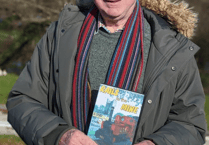WE'VE never been big on photography in our family. No bulging albums marking each tiny step in life, full of pictures to be brought out at family gatherings. The sole set of photographs of me as a baby were taken by a Daily Express photographer, a friend of my father. The poor man had probably been lured down to our village with the promise of a relaxing day in the countryside, only to be confronted with a rather grim baby and a demand to make it, or rather me, look cute. On the strength of these pictures, in which I look slightly cute, my grandmother entered me in the village baby contest later that year. It was judged by the local midwife and, instead of picking my grandmother's pride and joy, she chose an enormous dough baby with little tiny eyes – my grandmother would repeat this story for years so I knew by heart that I had been robbed of glory at an early age. I expect the midwife, surrounded by potential customers, decided that she'd better choose a local baby, and one which she'd delivered herself. My grandmother had gone home muttering 'fix' but I was never entered for any kind of beauty contest again. That was about it on the photograph stakes, apart from a few tiny black and white shots of summer holidays and the obligatory school photographs, we left nothing for posterity. We knew photographers, of course, mostly from national newspapers who did exciting things like taking pictures of criminals being hustled into police vans or leaping into cars to chase the latest big story. I got a camera as a gift when I was a teenager, which had instructions in German only, so I never got far with it. So, apart from a few fuzzy shots of the cat, the family remained uncharted in pictorial history. My wedding pictures were taken by another newspaper photographer, no doubt lured by promise of a boozy reception. He did the job but proved somewhat reluctant to come up with the prints. It took a year or so for him to get round to processing them and we never did get any reprints. I finally got round to getting a camera with instructions in English and vowed to start recording the family history. There are a few grainy shots of the babies when young, with me, so it's obvious that someone else took them. You can tell the ones I took, few of the people in them have a head. When the children used to ask why there were few pictures of them when young I had to point out that there are pictures, but only of torsos and legs. I have rows and rows of little legs standing on beaches and I can, if I look closely, identify whose legs they are. I have a perfect picture of my husband on horseback in Spain somewhere, taken from behind by me on another horse. Sadly, he lacks his head so he looks like one of those Greek statues. I never managed to grasp the art of getting everyone or everything into the centre of the picture. In my pictures the Eiffel Tower looks like an electricity pylon, Big Ben is clockless, Buckingham Palace is a bungalow, the Taj Mahal is a fish pond. Come to think of it, the Eiffel Tower always looks like an electricity pylon. But, in other words, I was only great at taking topless pictures. So I stopped taking pictures for decades until one day I woke up and saw a five year old taking pictures with a digital camera and thought 'If he can do it, so can I.' Mind you, I usually say that when I see any little child confidently programming a video or using the DVD or instantly knowing how to text on a new mobile telephone but it usually turns out that I can't. However, with a digital camera I could. It has little squares to tell you the centre of the picture, you can instantly look at what you have taken to make sure all heads are present. It's the idiot-proof camera that this idiot has waited a long time for. I started taking pictures of flowers, which don't move much and have more than one head in case old habits die hard. I then moved on to gardens and vistas and, finally, people. I'm now getting what is dubbed in the office as a bit 'arty farty' and taking pictures through holes in the wall or from behind a curtain of soft leaves. I talk about light and shadow and can soon see myself telling myself to stop being so blasted pretentious. The most complicated thing about the camera is the instructions on how to use it. Still, if anything, it proves that you can teach an old bitch new tricks.
T alking of teaching, I was really pleased the other day when my grandson said he was still following my instructions when making omelettes and they were still turning out well. We began cooking lessons when I was on holiday with them last year and his mum and dad were struck down with food poisoning (not from my cooking, I hasten to add). I took over cooking for the children, they obviously enjoyed helping and I enjoyed teaching them. I think I would have liked to be a domestic science teacher, except now I think they probably have a different name for it, and it's probably all about vitamin content, food groups, what not to eat etc., and not about learning how to make decent, wholesome food from fresh ingredients. I taught my own children to cook, although they occasionally baulked at some of my more outlandish dishes. When I was in my French period they had to put up with things like brains and sweetbread and pigs trotters so that they used to plead in tiny little voices for 'something normal', but generally all have a great enthusiasm for cooking all kinds of things and are very good at it. My greatest triumph was, however, teaching one of our Japanese au pairs to cook. We had two, one after the other, and English food really was totally alien to them and the first one used to send home plaintive letters begging for food parcels because she was homesick and sick of English cooking. These were the days when there was little in the way of exotic ingredients available, so her family used to send dried fish, shoyu sauce, seaweed, jars of pungent horseradish and other things. We were probably the only house in South East England to have a regular supply of tofu delivered and I converted my fondue maker into something which would cook tempura. The second one was totally different. She didn't want any of her national dishes cooked for her, so I threw out the tiny and very pungent dried prawns. She loved English food and wanted to learn how to cook it. For a year she watched carefully and helped. She was fascinated with Christmas food, taking to Christmas pudding and mince pies – I had to explain that you didn't put minced beef in them – and decorated cakes. She adored bacon and eggs, porridge, steak and kidney pudding and a full roast dinner. When she left I sent her home with a copy of the Good Housekeeping cookery book and a set of non-stick bake-ware. Also with her, she took the knowledge of how to make rhubarb crumble, treacle tart, dumplings, rock cakes, and Bakewell tarts. I like to think that somewhere in Japan there is a family tradition of sitting down to roast beef and Yorkshire pudding, with sprouts, peas, mashed potatoes and loads of roasties, followed by baked jam sponge and custard with Victoria sponge and cucumber sandwiches for tea. I dare say translating toad in the hole and spotted dick into Japanese was a bit difficult, but I hope she managed.



